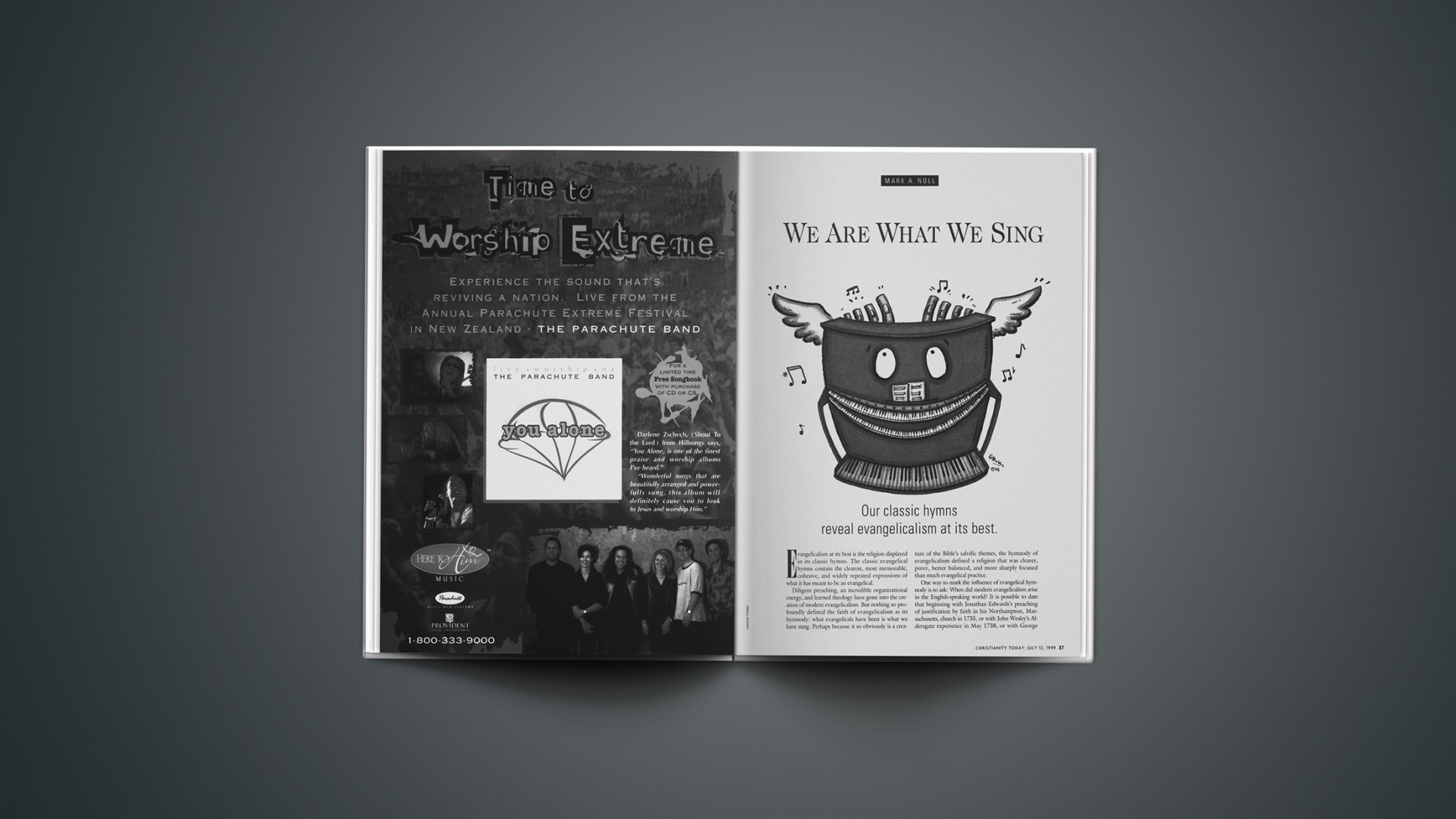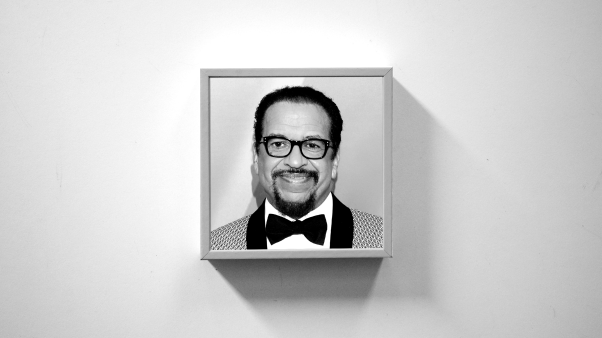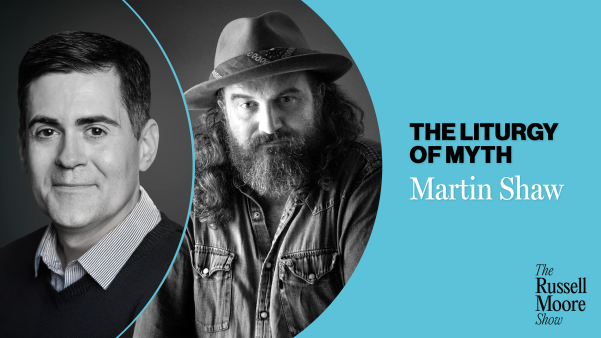Evangelicalism at its best is the religion displayed in its classic hymns. The classic evangelical hymns contain the clearest, most memorable, cohesive, and widely repeated expressions of what it has meant to be an evangelical.
Diligent preaching, an incredible organizational energy, and learned theology have gone into the creation of modern evangelicalism. But nothing so profoundly defined the faith of evangelicalism as its hymnody: what evangelicals have been is what we have sung. Perhaps because it so obviously is a creature of the Bible’s salvific themes, the hymnody of evangelicalism defined a religion that was clearer, purer, better balanced, and more sharply focused than much evangelical practice.
One way to mark the influence of evangelical hymnody is to ask: When did modern evangelicalism arise in the English-speaking world? It is possible to date that beginning with Jonathan Edwards’s preaching of justification by faith in his Northampton, Massachusetts, church in 1735, or with John Wesley’s Aldersgate experience in May 1738, or with George Whitefield’s momentous preaching tour of New England in September 1740. But it makes more sense to date the emergence of modern evangelicalism to an act of hymn composition by Charles Wesley.
The very week his brother John received an unusual manifestation of divine grace during a Moravian meeting at Aldersgate, Charles Wesley underwent a similar experience. Many know what John Wesley wrote in his journal after his experience: “About a quarter before nine, while [the speaker] was describing the change which God works in the heart through faith in Christ, I felt my heart strangely warmed. I felt I did trust in Christ, Christ alone, for my salvation; and an assurance was given me that He had taken away my sins, even mine, and saved me from the law of sin and death.” But many more people have sung the words that Charles composed about his transformation:
Where shall my wond’ring soul begin?
How shall I all to heaven aspire?
A slave redeemed from death and sin,
A brand plucked from eternal fire.
How shall I equal triumphs raise,
Or sing my great Deliverer’s praise?
… … … … … … … … … … …
Come, O my guilty brethren, come,
Groaning beneath your load of sin;
His bleeding heart shall make you room,
His open side shall take you in.
He calls you now, invites you home—
Come, O my guilty brethren, come.
If you doubt the weight of Charles Wesley’s contribution to the emergence of modern evangelicalism, ask yourself how many of the words of Edwards, Whitefield, or John Wesley you can quote, and then reflect on how much of Charles Wesley is stored away, not only in your brain, but in your heart:
Hark! the herald angels sing,
Glory to the new-born King; … “
Jesus, Lover of my soul,
Let me to thy bosom fly, …
Love divine, all loves excelling,
Joy of heaven to earth come down, …
Come, Thou long-expected Jesus,
Born to set Thy people free; …
Ye servants of God,
Your Master proclaim,
And publish abroad
His wonderful name; …
Christ the Lord is risen today, Alleluia!
Sons of men and angels say: Alleluia! …
The hymns of Charles Wesley and of his contemporaries like John Newton, Anne Steele, William Cowper, and William Williams (Pantycelyn) mark the first great outpouring of evangelical hymnody. The second appeared during the remarkable expansion of evangelicalism throughout Britain, Canada, and the United States during the first two-thirds of the nineteenth century.
Like the first wave, the classic hymns of the nineteenth century featured redemptive encounter with the living Christ described through images, tropes, metaphors, and quotations from the Bible. Evangelicalism always involved more than Christ-centered, biblically normed religious experience. But for leaders and followers alike, especially in day-to-day ordinary experience, that kind of piety remained the defining center of evangelical movements.
In the North Atlantic countries, massive efforts in evangelism, voluntary social reform, and the refinement of taste led to something like an evangelical cultural hegemony. One commonplace measure of nineteenth-century evangelical cultural influence is found in the incredible popularity of the hymns of Fanny Crosby of Brooklyn, New York. Among the approximately 8,500 hymns that this blind author wrote, dozens became defining emblems of evangelical experience:
Tell me the story of Jesus,
Write on my heart ev’ry word; …
All the way my Savior leads me;
What have I to ask beside? …
Blessed assurance, Jesus is mine!
O what a foretaste of glory divine!
… … … … … … … … … … …
This is my story, this is my song,
Praising my Savior all the day long.
The decades between the American War for Independence and the Civil War witnessed an accelerating evangelization of African Americans, both slave and free. When allowed, churches were formed and blacks exerted great energy in learning to read the Bible. Whether allowed or not, African Americans sang of their faith. The most distinctive form of that singing was the spiritual. Al though authorship, origin, and exact distribution of many spirituals lie beyond historical recovery, by midcentury the spiritual had become a sturdy anchor of African-American religion. The life course reflected in those spirituals was very different from the world in which Fanny Crosby lived. But one thing was similar: the use of biblical materials focused on the omnicompetence of Jesus Christ:
What ship is this that’s landed at the shore!
Oh, glory halleluiah!
It’s the old ship of Zion, halleluiah! …
What kind of Captain does she have on board?
Oh, glory halleluiah!
King Jesus is the Captain, halleluiah . …
The third wave of classic evangelical hymnody, which produced the gospel song, appeared at the turn of the twentieth century. For white evangelicals, Ira Sankey led the way. As D. L. Moody’s songleader, Sankey was an indispensable contributor to Moody’s phenomenal success in England, Scotland, Canada, and the United States. Much more than anything Moody ever wrote, Sankey’s songs long continued to speak of powerful evangelical sentiments:
There were ninety and nine that safely lay
In the shelter of the fold,
But one was out on the hills away,
Far off from the gates of gold.
… … … … … … … … … … …
[N]one of the ransomed ever knew
How deep were the waters crossed;
Nor how dark was the night that the Lord passed through
Ere he found his sheep that was lost.
The black counterpart to Ira Sankey was Charles A. Tindley, who, through patience, persistence, and tireless promotion convinced large numbers of African-American churches to enrich their singing with new hymns adjusted to a new era. Tindley is best known for a song published in 1916 that was later amalgamated with the spiritual “I’ll Be All Right” and sung to the tune of the latter spiritual as an anthem of the civil rights movement in the 1960s and ’70s. In its original version, the hymn’s most telling effect was to demonstrate continuity with the Christ-centered emphases of earlier evangelicalism:
This world is one great battlefield,
With forces all arrayed;
If in my heart I do not yield
I’ll overcome some day . …
… … … … … … … … … … …
Tho’ many a times no signs appear
Of answer when I pray,
My Jesus says I need not fear,
He’ll make it plain some day.
I’ll be like Him some day,
I’ll be like Him some day.
As is clear from the few hymns quoted here, these classics defined, with an unusual degree of unanimity, the essence of evangelicalism. Whatever their many differences of theology, ethnicity, de nomination, class, taste, politics, or churchmanship, evangelical hymnwriters and hymn singers pointed to a relatively cohesive religious vision.
Driving that vision was a peculiarly evangelical understanding of the Trinity. The holiness of God provided occasion for worship, but even more a standard that revealed human sinfulness, guilt, and need for a Savior. At the heart of the evangelical hymnody was Jesus Christ, whose love offered to sinners mercy, forgiveness, and reconciliation with God. In this Savior redeemed sinners found new life in the Holy Spirit, as well as encouragement to endure the brokenness, relieve the pain, and bind up the wounds of a world that the great evangelical hymn writers almost always depicted in strikingly realistic terms.
A Christ-centered picture of redemption is the scarlet thread running through classic evangelical hymns.
In at least three specific ways, the classic hymns display evangelicalism at its best: First, a Christ-centered picture of redemption is the scarlet thread running through these hymns. This picture of redemption insists upon the death of Christ on the cross as the only ultimate source of human salvation. What makes the hymns evangelicalism at its best is that in them the boundary of offense is restricted narrowly to the scandal of the Cross. Second, the classic evangelical hymns were used for an unusually broad, unexpectedly gracious, ecumenicity. Third, the social vision that constitutes a prominent subtheme in these hymns evokes a remarkably winsome vision of altruistic Christian charity.
The scandal of the Cross Prof. Stephen Marini of Wellesley College has twice in recent years tallied the most-often reprinted hymns in American Protestant hymnbooks from the colonial era to the decades after World War II. He has identified two different hymns as the most often reprinted in American Protestant history. The message of one of those is so often repeated in so many of the other classic hymns of evangelicalism that its compact, forceful lines are an especially good record of the center of evangelical concern. That hymn appeared in 1776, the same year as the signing of the Declaration of Independence and the publication of Adam Smith’s Wealth of Nations. Of all world-historical occurrences that year, the publication of August Montagu Toplady’s hymn may have been the most consequential:
Rock of Ages, cleft for me,
Let me hide myself in Thee;
Let the water and the blood,
From Thy riven side which flowed,
Be of sin the double cure,
Cleanse me from its guilt and power.
Toplady’s theme was never put more succinctly, with more theological acumen and greater dramatic power than in a hymn Charles Wesley wrote at the very beginning of the evangelical movement:
And can it be that I should gain
An interest in the Savior’s blood?
Died he for me, who caused his pain?
For me, who him to death pursued?
Amazing love! How can it be
That thou, my God, shouldst die for me?
‘Tis myst’ry all! th’ Immortal dies!
Who can explore his strange design? …
It is impossible to illustrate quickly the fixation of evangelical hymnody on the saving death of Christ. The theme is prominent even in many songs written for children (“Jesus loves me, this I know”). It remained a fixture in the memorable, though more sentimental, hymns of the Victorian era, as Philip P. Bliss’s “Man of Sorrows” or Horatio G. Spafford’s “It Is Well with My Soul.” Even in the much more therapeutic concerns of the modern praise chorus, emphasis upon the redemption won by Christ on the cross is by no means absent.
The classic evangelical hymns do not offend on doctrines of the church and the sacraments because they touch on these matters only indirectly, if at all. Neither do they offend by promoting the particular doctrines of a faction. While the great hymns everywhere betray implicit trust in the Scriptures, they do not offend by insisting on a particular definition of biblical authority. Again, the classic evangelical hymns have virtually no politics.
The classic evangelical hymns are virtually innocent of such offenses. Rather, their overriding message and the single offense upon which they insist is compacted into the four words that best summarize their message: Jesus Christ Saves Sinners. These hymns, in other words, proclaim a particular redemption of substitutionary atonement through a particular act of God accomplished in the particularities of the birth, life, death, resurrection, ascension, and kingly rule of Jesus Christ.
Evangelicalism at its best is an offensive religion. It claims that you cannot be reconciled to God, understand the ultimate purposes of the world, or live a truly virtuous life unless you confess your sin before the living God and receive new life in Christ through the power of the Holy Spirit. Such particularity has always been offensive, and in the multicultural, postmodern world in which we live it is more offensive than ever. But when evangelicalism is at its best, as it is in its greatest hymns, that declaration of a particular salvation is its one and only offense.
The ecumenicity of the gospel Evangelicals may never have been as factious or sectarian as is commonly thought. To be sure, leaders of evangelical groups have indulged in their fair share of back-stabbing, power-mongering, petty-minded polemicizing, gratuitous boundary-marking, and schismatical devilment. Although I am convinced that lay evangelicals have done better than their leaders in preserving the unity of the body of Christ, there is enough fragmentation in the evangelical world to go around for all. For example, the presence of three confessional Presbyterians guarantees at least four potentially schismatic opinions on the doctrine of predestination.
Evangelicalism at its best, however, embodies a kind of gospel ecumenicity that, while it does not overcome the fragmentation to which evangelicalism is prone, nonetheless speaks forcefully against it. In this case, evangelical hymnody has been more an eschatological sign of a unity to come than of a unity realized. Specifically, it is not so much the message of the hymns as how they are used that displays most clearly their ecumenical potential.
The folks I talk to are my fellow human beings; the ones I sing with are family.
John Wesley, for example, eventually broke with the Moravians: they were too passive, too mystical, perhaps too cheerful. But he did not hesitate to translate a few of their hymns. The result is that generations of evangelicals to this day have joined their voices in singing the cooperative efforts of Wesley the Methodist and Zinzendorf the Moravian long after the Moravians and Methodists went their separate ways. And what they have sung is, “Jesus, thy blood and righteousness / My beauty are, my glorious dress.”
Some of the ecumenicity of the great evangelical hymns bridges even wider chasms. At the end of the nineteenth century, many evangelicals still regarded the pope as Antichrist and, if they thought of it at all, considered the Oxford Movement but a way station toward Rome. Yet within the same generation that they were written, John Henry Newman’s “Lead Kindly Light” and John Keble’s “Sun of My Soul, Thou Savior Dear,” were being sung by evangelicals. Moreover, a translation by the evangelical Presbyterian James Waddel Alexander of Paul Gerhardt’s German translation of Bernard of Clairvaux’s “O Sacred Head, Now Wounded” had be come a fixture in evangelical hymnbooks.
It is also ecumenically significant to ponder the translating history of Martin Luther’s “Ein Feste Burg” (“A Mighty Fortress”), the very Marseilles Hymn of the Reformation that English-speaking evangelicals were also singing widely by the end of the nineteenth century. Two of the most popular translations of that great hymn were in fact made by individuals whose theological convictions would have excluded them from leadership in almost all evangelical churches—George Mac Donald, a renegade Scottish Congregationalist run off into Universalism, and Frederick Hedge, a graduate of the Harvard Divinity School and promoter of Unitarianism as a pastor and professor.
The ecumenicity of the classic evangelical hymns extends beyond ecclesiastical division to the polarities of gender and race as well. Although these hymns follow the conventions of their day in using masculine pronouns for all humans, they do not promote gender wars, and only a lunatic fringe of evangelicals has ever scrupled at not only singing, but singing with enthusiasm, the hymns of Fanny Crosby, Charlotte Elliott, Frances Ridley Havergal, Carolina Sandell, Cecil Frances Alexander, and Margaret Clarkson.
Race, the most intractable divider of Christians in the modern West, is not in tractable enough to completely stifle the gospel ecumenicity of evangelical hymnody. Many of us white bread evangelicals act uncomfortable in black churches, and I suspect that many African Americans feel the same way in white churches. Yet the white folk still try to sing “A Little Talk with Jesus Makes It Right” or Thomas A. Dorsey’s “Precious Lord, Take My Hand.”
Although on ecumenical matters evangelicals have not always been at their best, in the spirit with which the classic evangelical hymns have been put to use, evangelicalism expresses an ecumenical vision shaped by the gospel itself. By so doing they illustrate in a specifically Christian way the truth of a German saying: the folks I talk to are my fellow human beings; the ones I sing with are family.
A social vision An important subtheme in the classic evangelical hymns is a persistent concern for the relief of suffering. Although this subtheme is almost never developed systematically or structurally, it is nonetheless there from the first, as in the hymn of Isaac Watts:
Blessings abound where’er he reigns;
The prisoner leaps to lose his chains,
The weary find eternal rest,
And all the sons of want are blest.
As J. R. Watson points out in his fine recent book, The English Hymn, “Charles Wesley’s hymns are forceful because they contain so many words which are physical: for him the life of a Christian was to be experienced in the body as well as in the soul.” Thus, the note struck in Wesley’s “O for a thousand tongues to sing” is by no means untypical:
Hear him, ye deaf; his praise, ye dumb,
Your loosen’d tongues employ;
Ye blind, behold your Savior come,
And leap, ye lame, for joy.
The challenge to this-worldly service is often repeated in Wesley’s hymns:
A charge to keep I have,
A God to glorify;
A never-dying soul to save,
And fit it for the sky.
To serve the present age,
My calling to fulfill;
Oh, may it all my powers engage
To do my Master’s will!
In the Victorian era, Fanny Crosby ex pressed directly the care that at least some evangelicals showed to those for whom few others cared:
Rescue the perishing, care for the dying,
Snatch them in pity from sin and the grave;
Weep o’er the erring one, lift up the fallen,
Tell them of Jesus the mighty to save.
At its best, the evangelical desire to rescue the perishing has meant putting the perishing on their feet in the here and now as well as preparing them for eternity. Of course, we evangelicals are often not at our best, so the occasions are many of having been lured away from Christ-inspired social service by prejudice, class-consciousness, middle-class fastidiousness, blindness to the structural conditions of power that condition personal choices, and the many other forms of social sinfulness that beset the human race in general.
But at its best, evangelicalism is William Wilberforce, who, for the sake of the kingdom of Christ, devoted his life to the destruction of slavery. At its best, evangelicalism is the Grande-Ligne Mission of Madame Henriette Feller, who in Quebec patiently joined Protestant witness to educational exertion. At its best, evangelicalism is the tireless, unpretentious, but absolutely stunning social achievements of the Salvation Army and the Mennonite Central Committee. And at its best, evangelicalism is the motivation from the Gospel of Mat thew that has inspired many to establish shelters for pregnant women in distress and to march on pro-life picket lines: “Come to me, all who labor and are heavy laden, and I will give you rest. Take my yoke upon you, and learn from me; for I am gentle and lowly in heart, and you will find rest for your souls” (11:2829).
Concern for the terrestrial outworking of the kingdom of God is not as fully developed in the classic evangelical hymns as it should be. But it is indubitably there, reflecting a vision of human need inspired by the love of Jesus and devoted, not to extrinsic social or political causes, but to the good of the ones being served.
Wheat with the tares In the history of evangelicalism, for every Jonathan Edwards dedicating the mind to discern the glories of God in the stuff of daily human existence, there are many James Davenports running amuck into mind-denying enthusiasm. For every William Jennings Bryan eager to judge the marketplace by the Cross, there is a Russell Conwell eager to bury the Cross in an acre of diamonds. For every Johann Albrecht Bengel or Gordon Fee examining issues of biblical interpretation with pain staking care, there are many more evangelicals racing from slipshod plundering of the biblical text to bogus exegetical certainties. For every Wilber force bringing the resources of evangelical faith to bear for spiritual and terrestrial liberation, there is a James Henley Thornwell bringing pretty much the same resources to bear for a now incomprehensible mixture of spiritual liberation and terrestrial enslavement. For every Billy Graham maintaining theological, financial, and sexual integrity as a traveling evangelist, there is a Marjo exploiting kerygmatic charisma for base ends.
These contrasts are illustrated in Charles Marsh’s captivating recent study, God’s Long Summer: Stories of Faith and Civil Rights (1997), about the dramatic civil-rights confrontations of 1964 in the state of Mississippi: for every Fannie Lou Hamer who was sustained by thoughts of Jesus as she was being beaten in the Winona, Mississippi, city jail, there is a Sam Bowers, Imperial Wizard of the White Knights of the Ku Klux Klan, believing that he was defending the sovereignty of God and the resurrection of Jesus Christ by conspiring to murder three civil-rights workers.
From a historical perspective, therefore, I am reluctant to conclude too much about the question of whether evangelicals in practice have lived up to the vision of faith and life found in the great evangelical hymns. Yet, as a historian who is also an evangelical, I must say more. Even if, historically considered, evangelicals have not always acted at our best, evangelical convictions are not compromised. In fact, they may be strengthened.
It is evangelical to insist that humans are redeemed by God’s grace rather than by the achievement of their own perfection; it is evangelical to claim that the righteousness on which we rely is a forensic gift rather than a personal possession; it is evangelical to claim that power resides in powerlessness and that the Cross is a symbol both for human weakness as well as divine love. Holiness unto the Lord is a prominent evangelical theme, but it rests upon justification by faith alone.
Thus, even if evangelicals have acted at our best only inconsistently, there is nothing in that fact contradicting evangelical conviction. In fact, for evangelicals to confess how far short they have fallen of the divine beauty that they claim to honor is a very important first step to ward realizing evangelicalism at its best.
In the second survey made by Professor Marini, “All Hail the Power of Jesus’ Name” emerges as the most-often reprinted hymn in American Protestant hymnbooks. This hymn’s story reveals much that is typical of evangelicalism. As an indication of the kind of ecumenism that flourishes among evangelicals, the version of the hymn most often sung today actually represents an original composition of Edward Peronnet, who was a pedobaptist associated primarily with the Methodists, and John Rippon, a Baptist. In addition, the tune Diadem, the most lively of several tunes to which the hymn is sung, was composed by an 18-year old Wesleyan hatmaker, James Ellor.
Less auspiciously, Edward Perronet’s career is also not untypical of evangelicalism. Perronet, it turns out, was not an easy chap to get along with. As a young man, he eagerly joined in the work of the Wesleys, but his zeal for revival led him to bitter attacks on the Church of England that soon alienated him from the Wesleys, who always saw their work as a complement to official Anglicanism. Perronet next took one of the chapels in the Countess of Huntingdon’s Connection, but the violence of his festering anti-Anglicanism remained so strong, he wore out the countess’s patience and finally ended up pastoring a Congregational church. Evangelicalism at its best is not the career of Edward Perronet. Evangelicalism at its best, rather, is the hopes, dedication, aspirations, and longing that have led tens, maybe hundreds, of millions of evangelicals to sing, decade after decade, and with all their hearts:
All hail the power of Jesus’ Name!
Let angels prostrate fall;
Bring forth the royal diadem
And crown him Lord of all.
Sinners, whose love can ne’er forget
The wormwood and the gall,
Go, spread your trophies at his feet,
And crown him Lord of all.
O that with yonder sacred throng
We at his feet may fall,
Join in the everlasting song,
And crown him Lord of all.
Mark A. Noll is McManis Professor of Christian Thought and professor of history at Wheaton College. This article is adapted from a lecture Noll delivered at Harvard Divinity School to inaugurate the Alonzo L. McDonald Family Visiting Professorship in Evangelical Theological Studies and was first published in the Harvard Divinity Bulletin.
Copyright © 1999 Christianity Today. Click for reprint information.










